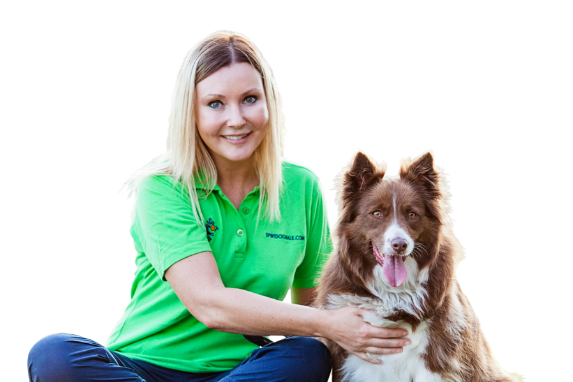Restraining a Pulling Pooch
By Anne-Marie George
Born free, or at least this is impression the David Attenborough’s of the dog world have conveyed when I’ve watched TV dog shows. However, this is certainly not the common experience of our family dogs in present society. In fact, it is illegal for a dog to roam free in most places, not to mention dangerous, frightening and unwise. Nevertheless, we all know that exploration beyond the bounds of home is invaluable for our dog’s fitness, socializing and stimulation. So out we go; collar and leash fastened; poo bag at the ready. Let the games begin!
Transitioning a family/house dog, whose natural instinct is to be free, into a well mannered, calm walking companion is a task. There are many components involved, which we will investigate in subsequent weeks, but for this week we’ll discuss the pros and cons of the various collars and leashes.
Many dogs wear collars. They’ll often have some sort of ID and registration tags, along with a clip in which to attach a leash. This straightforward combination is an adequate walking option for an easy-going, obedient dog, as the collar can be worn at all times and the whole set-up is easy to use. However, it offers little assistance when trying to control a naughty or pulling dog.
Several years ago choker chains seemed to be the solution for controlling excitable dogs, however they can be quite horrendous when not fitted and/or used correctly. The idea is that when the dog deviates from desirable walking behavior the handler will yank the cord, which will then tighten around the dog’s neck creating an unpleasant feeling. That it certainly does. Ironically despite the pooch virtually choking to death, this collar isn’t particularly effective at reducing pulling. Furthermore, it is tricky to apply. Firstly, the chain must be the correct length: too long allows excess slack, too short and there’s insufficient momentum for the jerk. Also, the most effective correction occurs if the choke is high, right behind the ears (eg. Cesar Milan’s Illusion Collar), however maintaining this position can be difficult. Additionally, the chain needs to go on correctly. It must form a “P” with the tail of the “P” on the same side of the handler. Then, there’s the potential ramifications of chocking – exacerbating airway issues, causing neurological problems and Horner’s Syndrome, which results in changes in the pupil of the eye and nerve and inducing lameness in the front leg. Finally, if it is left on the pet and they are unsupervised it could potentially strangle the dog if it panics.
Shying away from restrains around the neck, the harness, in all of its various forms, distributes pressure around the larger and more powerful parts of the body, thus making it difficult to lunge and pull. Essentially, straps of nylon (commonly) are positioned around the front legs, upon the chest and over the back, with the leash either attaching on the back or on the chest. There are also harnesses that strap around the back legs. All harnesses work in much the same way, with the aim to apply pressure to the chest, shoulders, legs, armpits or back legs when the dog pulls. According to the website Pet Expertise, (http://www.petexpertise.com/dog-training-article-comparison-of-no-pull-dog-training-aids.html), harnesses, especially front attachment harnesses are the most effective at restraining wild walking behavior, although they do warn of the importance of accurate fitting to ensure maximum effect and the possibility of chaffing if the restraint is not padded. The harness is also ideal for short nose breeds like pugs and miniature poodles. However, I must warn that they can be a nightmare to fit for the uninitiated so detailed instruction and practice is a must upon purchase.
Finally, is the head-halter, which fits around the dog’s nose and works in much the same way as that of a horse’s halter. When the dog pulls its’ head naturally turns toward the handler thus giving them control. This is particularly important as where the head points the body will follow. Wearing a head-halter is unsuitable for short-nosed breeds and will require some training but if your dog is a determined puller it is well worth the effort. Just beware to limit the length of the leash to less than 1.8m in order to minimize possible neck strain.
Through my research I also came across a restraint known as a pinch or prong collar. Essentially, it’s a collar with spikes on the inside, which pinch the skin of the neck when the dog pulls. The reviews I have read seem reasonable positive toward it but I cannot move past how cruel and inhumane it appears. I don’t know if they are available in Australia but don’t recommend seeking them out.
Training a dog to walk sensibly is a time-consuming and potentially expensive job. It may take a few false starts but there will be a collar and leash combination that works well for you and your pooch. Persevere as witnessing the joy in your dog and experiencing the fun you’ll both have exploring the great outdoors together will make all that investment well worth the effort.
References
Choosing the Right Leash and Collar, Cesar’s Way, 29th July 2013, http://www.cesarsway.com/dog-care/new-dog/Choosing-the-Right-Leash-and-Collar
Dogs Collars and Leashes, Paws About, 29th July 2013, http://www.pawsabout.com.au/dog-collars-leashes/
Rollins, J. Comparison of No-Pull Dog Training Aids, Pet Expertise, 29th July 2013, http://www.petexpertise.com/dog-training-article-comparison-of-no-pull-dog-training-aids.html



